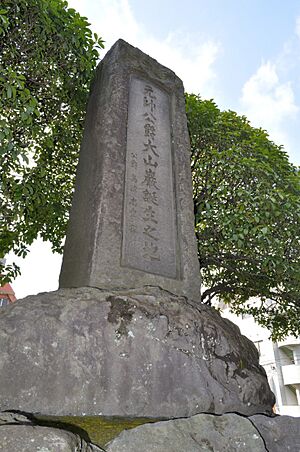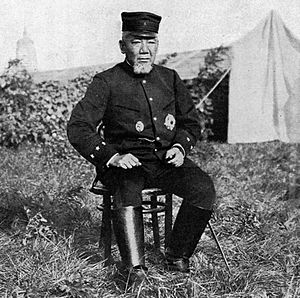Ōyama Iwao facts for kids
Quick facts for kids
Prince
Ōyama Iwao
大山 巌 |
|
|---|---|
 |
|
| Lord Keeper of the Privy Seal | |
| In office 23 April 1915 – 10 December 1916 |
|
| Monarch | Taishō |
| Preceded by | Prince Fushimi Sadanaru |
| Succeeded by | Matsukata Masayoshi |
| 1st & 3rd Minister of War of the Japanese Empire |
|
| In office 22 December 1885 – 17 May 1891 |
|
| Monarch | Meiji |
| Preceded by | Position established. |
| Succeeded by | Takashima Tomonosuke |
| In office 8 August 1892 – 20 September 1896 |
|
| Preceded by | Takashima Tomonosuke |
| Succeeded by | Takashima Tomonosuke |
| Chief of the Imperial Japanese Army General Staff Office | |
| In office 4 September 1882 – 13 February 1884 |
|
| Monarch | Meiji |
| Preceded by | Yamagata Aritomo |
| Succeeded by | Yamagata Aritomo |
| In office 16 May 1889 – 20 June 1904 |
|
| Preceded by | Kawakami Soroku |
| Succeeded by | Yamagata Aritomo |
| In office 20 December 1905 – 11 April 1906 |
|
| Preceded by | Yamagata Aritomo |
| Succeeded by | Kodama Gentarō |
| Personal details | |
| Born | 12 November 1842 Kagoshima, Satsuma Domain (now Kagoshima, Japan) |
| Died | 10 December 1916 (aged 74) Tokyo, Japan |
| Awards |
|
| Military service | |
| Allegiance | |
| Branch/service | |
| Years of service | 1871–1914 |
| Rank | Field Marshal |
| Battles/wars |
|
Prince Ōyama Iwao (born November 12, 1842 – died December 10, 1916) was a very important Japanese military leader. He became a field marshal and helped create the modern Imperial Japanese Army. He played a key role in many important events in Japan's history.
Contents
Ōyama's Life and Military Career

Early Years and the Meiji Restoration
Ōyama Iwao was born in Kagoshima, Japan. His family were samurai, who were like noble warriors. He was a cousin to another famous samurai, Saigō Takamori.
Ōyama helped to overthrow the Tokugawa Shogunate. This was the old government of Japan. He played a big part in the Meiji Restoration. This was a time when Japan changed from a feudal society to a modern empire.
During the Boshin War, which was a civil war in Japan, Ōyama was a commander. He led artillery forces and was even wounded in a battle.
Studying Abroad and Building the Army
In 1870, Ōyama traveled to France to study military tactics. He even observed the Franco-Prussian War. He also spent three years in Switzerland, where he learned to speak Russian fluently. Later, he studied in the United States.
When he returned to Japan, he helped build the new Imperial Japanese Army. This new army was soon tested when it had to put down the Satsuma Rebellion. This was a revolt led by his cousin, Saigō Takamori.
Leading in Major Wars
Ōyama Iwao was a top commander in two major wars.
- First Sino-Japanese War (1894-1895): He led the Japanese Second Army. His forces captured Port Arthur and later Weihaiwei. After this war, Ōyama was given the title of marquis. This is a high rank in the Japanese noble system.
- Russo-Japanese War (1904-1905): He was the Commander-in-Chief of all Japanese armies in Manchuria. He was in charge of all land operations. He led Japanese forces to victories in battles like Battle of Liaoyang and Battle of Mukden. He directed the tactics for these important wins.
After Japan won the Russo-Japanese War, Emperor Meiji gave Ōyama the highest noble rank: prince.
Political Roles and Later Life
Ōyama also held important political positions. He was the Minister of War several times. He also served as the Chief of the Army General Staff. These roles meant he had a lot of power in the government.
He was known for being a quiet person who usually stayed out of politics. From 1914 until his death, he was the Lord Keeper of the Privy Seal. This was a very trusted position.
Ōyama Iwao received many honors from Japan and other countries. For example, he received the Order of Merit from King Edward VII of the United Kingdom. He also had Japan's highest awards, like the Order of the Golden Kite and the Order of the Chrysanthemum.
Ōyama passed away in 1916 at the age of 75. He was known for being a large man who enjoyed big meals.
Ōyama's Family and Home
His Family Life
Ōyama's first wife, Sawa, passed away. His second wife was Sutematsu. She was a very special person. She was one of the first Japanese girls sent to study in the United States. This happened as part of the Iwakura Mission in the 1870s. She studied there for eleven years and graduated from Vassar College.
Ōyama and Sutematsu had children. Their first son, Takashi, was a navy cadet. Sadly, he died in an accident when a ship exploded in 1908. Their second son, Kashiwa, became an archaeologist after he left the army.
His European-Style House
Ōyama Iwao loved European culture. He could speak and write several European languages. He also liked European-style buildings. When he was the War Minister, he built a large house in Tokyo. It looked like a German castle!
However, his wife Sutematsu didn't like the castle design for the children's rooms. She wanted them to be in Japanese style. She felt it was important for their children to remember their Japanese heritage. Sadly, this unique house was destroyed by the Great Kantō earthquake in 1923.
Ōyama and Japan's National Anthem
Ōyama Iwao played a part in the creation of Japan's national anthem, Kimigayo. In 1869, a British military band instructor named John William Fenton suggested that Japan should have its own national anthem, just like Britain had "God Save the King".
The band members asked Ōyama Iwao for help. He was very good at Japanese and Chinese literature. Ōyama chose a poem that became the words for Japan's national anthem, Kimigayo.
Honors and Recognition
Ōyama Iwao received many high honors during his lifetime.
- He was given the highest Japanese noble titles: Marquis and later Prince.
- He received the Collar of the Order of the Chrysanthemum, which is Japan's highest order.
- He also received the Order of the Golden Kite (1st class) for his military achievements.
- From other countries, he received the Order of Merit from the United Kingdom.
- He was also honored with the Grand Cross of the Legion of Honour from France.
Ōyama Iwao is remembered in other ways too. A small town in British Columbia, Canada, called Oyama, British Columbia, is named after him. There is also Oyama Regional Park in Saskatchewan, Canada.
See also
 In Spanish: Ōyama Iwao para niños
In Spanish: Ōyama Iwao para niños




